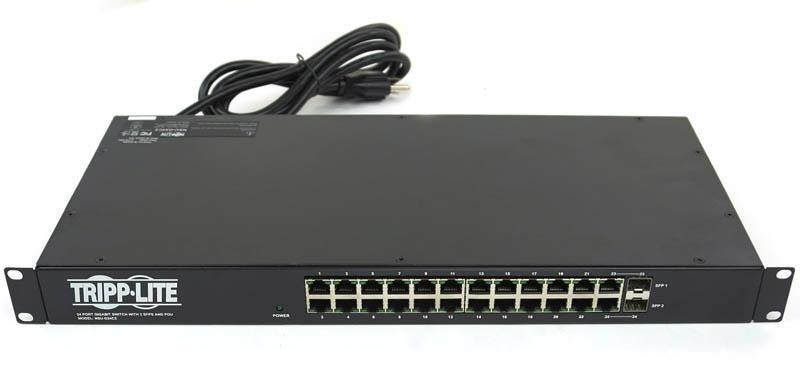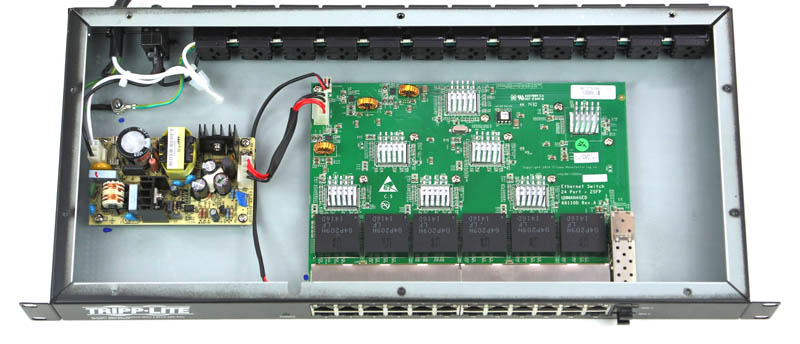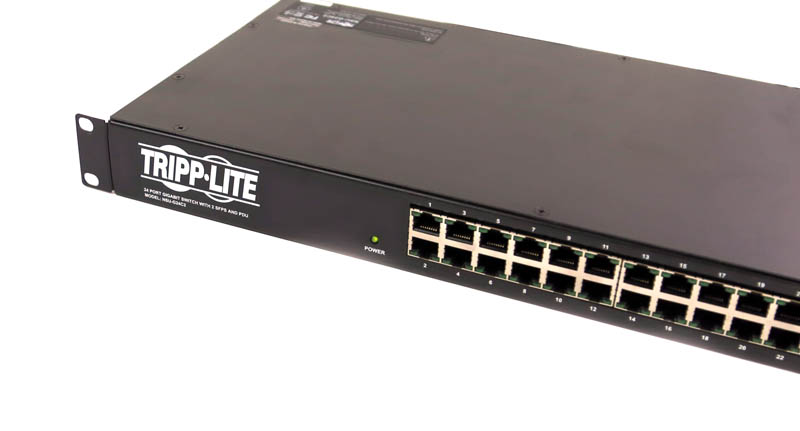Today we are reviewing the Tripp Lite NSU-G24C2 switch and PDU combo unit. The Tripp Lite NSU-G24C2 is an extremely handy device, especially for those running smaller 1/4 or 1/2 cabinet installations. It is a 1U short depth device that serves two primary purposes: 1) serving as a 12 outlet PDU and 2) serving as a 24-port gigabit unmanaged switch. When space is tight, this is an excellent combo device which does save significant space. Suffice to say, when a forum member first pointed the device out, we contacted Tripp Lite immediately to get a review unit in the datacenter lab.
Tripp Lite NSU-G24C2 Overview
The Tripp Lite NSU-G24C2 is a relatively simple device. The front side of the unit has a 24-port switch with 2x SFP gigabit links as optional interfaces. As an unmanaged switch, some of the higher-end features such as being able to segment sets of ports for vLANs, link aggregation and etc. were not available. On the other hand, as many will attest to, sometimes having simple plug-and-play switches can be useful.

The rear of the unit has 12x NEMA 5-15R AC outlets outlets as well as an input cord. Total power rating is 12A @ 120v or 1.44kW and the unit does have a circuit breaker.

Inside the Tripp Lite NSU-G24C2 we see all that is going on in the chassis. One can see the outlets along the top side, a power supply for the switch and the large green switch PCB with the switch chips covered in heatsinks. There are no fans in this unit so everything is passively cooled.

We installed into our Fremont, California datacenter lab. and found an exceedingly awesome use for the Tripp Lite NSU-24C2 – as an IPMI/ management interface switch. We had 18 management interfaces that we wanted to tie to a specific LAN segment that required its own VPN. We ended up using the uplink port to our router and had a VPN setup specifically to access the management ports on this switch. Suffice to say this was extremely simple to setup and manage while allowing us to use more expensive managed switch ports for other purposes.

Tripp Lite NSU-G24C2 Power Consumption
We utilzied our Extech 380803 TrueRMS power meter to check how much power the Tripp Lite NSU-G24C2 was pulling. Given there is an unmanged switch that claims to be “green” we wanted to see how much power the switch used. Here is an example of the unit with only two gigabit switch ports plugged in.

This is certainly in-line with other unmanaged switches we have seen with each additional switch port utilized adding an incremental 0.1w to 0.2w to the total power draw.
What we would like to see
Sometimes it is hard to resist the urge to play product manager and think of what would be extremely useful for future revisions. We had some thoughts:
- 10Gb SFP+ capabilities – the switch was practically limited in application by the lack of management features and higher-speed networking. While we could push gigabit speeds (~125MB/s) port-to-port, at some point having higher-speed networking would make the switch more useful
- Managed switch capabilities – having the ability to handle vLAN tagging and link aggregation as examples would start to make this switch a replacement for many 1/4, 1/2 and potentially full cabinet applications
- LED power consumption display – our zero U PDU in the rack we used for testing has a simple display to show overall power usage in amps. This would be an excellent feature to have
- Remotely managed PDU/ switch – having a management interface to remotely switch each of the power outlets like some higher-end PDUs would certainly add complexity and costs, but if we are going to make a wish-list…
Certainly all of these wish list items would add cost and complexity but the prospect of saving 1U of space combining switch and PDU is significant.
Tripp Lite NSU-G24C2 Switch Specs
Here are the official Tripp Lite specs on the unmanaged Ethernet switch:
-
24 RJ45 Gigabit Ethernet ports
-
Auto-negotiable 10/100/1000 Mbps Ethernet on all ports selects port speed automatically based on the capabilities of the client
-
Auto MDI/MDIX crossover detection provides true, plug-and-play functionality
-
Two SFP (Mini-GBIC) ports for uplinking to other switches using optical fiber. Each SFP port is shared with a RJ45 port. When the SFP port is active, the corresponding RJ-45 port will be disabled.
-
48 Gbps switching capacity at Full-Duplex
-
Store-and-Forward switching method
-
2Mb RAM for data buffering
-
8K address MAC address table
-
Supports Jumbo Frames up to 9216 Bytes
-
Power ON/OFF LED illuminates to indicate that the switch is receiving power
-
RJ45 LED’s Per Port (Left LED Blinks Green for Activity, Right LED is off for 10/100 Mbps speeds, and solid Green for 1000 Mbps)
-
Compliant with IEEE 802.3ab (1000BASE-T GbE), IEEE 802.3u (100BASE-TX Fast Ethernet), IEEE 802.3i (10BASE-T Ethernet), IEEE 802.3x (Full Duplex/Flow Control), IEEE 802.3 (NWAY Auto-Negotiation), 802.3ac (VLAN) and 802.3az (Energy Efficient Ethernet)
Conclusion
Overall the Tripp Lite NSU-G24C2 is an amazing value. For a $220 street price saving 1U of space is excellent. The space savings alone is probably worth the entire purchase price over a year period. If you do have a use case needing the power distribution and an unmanaged switch – this is the box to get. Given that it is low power and fanless, beyond the datacenter the unit also makes a great addition to home/ SMB office infrastructure.





Can’t say I am excited to see this product. Trying to save rack space doesn’t really cut it when I see wire gauge on the lighter side (Yanks run half the voltage, twice the current) with a cheap crimp on the wires to tap power for the switch.
The next big issue, putting a low-level network device inside the same metal can as mains equipment goes against everything we have here in Oz about cabling/data rules.
Not even go on possible issues of induced noise sitting inside the same metal can.
Hi,
First thing first, thank you so much for this great website, resources and community ! Can’t count how many time I’ve found in this pages the exact accurate information I was looking for… and often, those I didn’t even know I was before I got here.
The question part now… does anybody knows where I could buy this kind of switch module/board ?
Thanks in advance for your answer
Bests